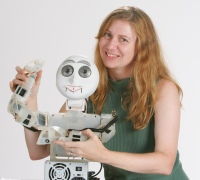. "On the use of the term "Stigmergy"". Poster paper in 2nd International Workshop on the Mathematics and Algorithms of Social Insects , 193-193, Dec 2003. (.pdf)
The concept of stigmergy has been applied to a number of fields since it was first coined in the 1950's (Grass\'e, 1959). We have compiled a bibliography (Available for download at http://robotics.usc.edu/~dshell/stigmergy.html) of over a hundred works that make use of the term, with the focus on artificial applications (robotics, optimization, routing,etc) but also including important works from entomology, and a few that treat the general concept of stigmergy. Based on the varied perspectives of these documents, it is clear that the term has come to mean different things to different people. One possible source of confusion is its relationship with self-organization. Bonabeau,~E. Theralulaz,~G. & Deneubourg,~J.-L. (1999) mention that, when stigmergy and self-organization work together, they can account for a wide range of observable phenomena. This view, in which the two phenomena are seen as cooperating but distinct, is not shared by all (cf. Michalareas,~T. & Sacks,~L. (2001)). For instance, some authors consider positive feedback an important part of stigmergy itself, while others consider the two phenomena to overlap (Anderson,~C 2002). Most frequently, authors use the term only in passing, often with a one-line definition claiming that it is a form of indirect communication. Some have taken stigmergy to mean something similar to generative communication, while others mention shared external memory metaphors (e.g. Peshkin,~L.M. Meuleau,~N & Kaelbling,~L.P. (1999)). Still others tend to take a less general view; a number of papers from the `pheromone computation' literature consider only a very limited notion of what stigmergy is, one that includes features of self-organization. Although P.P.Grass\'e's (1959) original definition is well cited (in over half of the papers in our collection), even it has been interpreted in multiple ways. The differences are typically subtle enough and based on peripheral examples, to further perpetuate confusion and misuse of the term.
@inproceedings{Shell-2003-354,
author = "Dylan A. Shell and Maja J. Matari{\'c}",
title = "On the use of the term {\&}quot;Stigmergy{\&}quot;",
booktitle = "2nd International Workshop on the Mathematics and Algorithms of Social Insects",
pages = "193-193",
month = "Dec",
year = "2003",
url = "http://robotics.usc.edu/publications/354/"
}
| Name: | Dylan A. Shell |  |
| Position: | PhD Student | |
| Email: | dshell@robotics.usc.edu | |
| Homepage: | http://robotics.usc.edu/~dshell | |
| Status: | current |
| Name: | Maja J. Matarić |  |
| Position: | Professor of Computer Science and Neuroscience | |
| Email: | maja@robotics.usc.edu | |
| Address: | 3650 McClintock Avenue, OHE 200 Los Angeles, CA 90089-1450 | |
| Homepage: | http://robotics.usc.edu/~maja | |
| Phone: | 213-740-4520 | |
| Fax: | 213-821-5696 | |
| Status: | current |
